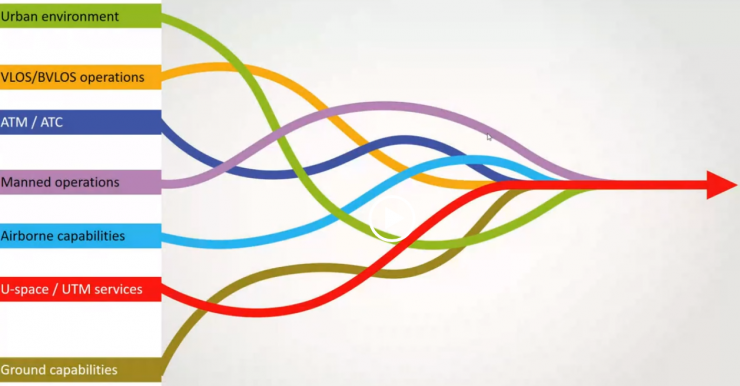By Jenny Beechener
The SESAR Joint Undertaking described three high priority research areas as the focus for the next phase of U-space research and development. The update comes close on the heels of publication of the consolidated results of 19 exploratory research and demonstration projects in the document Supporting safe and secure drone operations in Europe. “From now on, everything is about convergence and integration,” said Ludovic Legros, SJU Programme Manager, speaking at the SJU webinar on U-space consolidated research results on 12 November 2020. The programme aims to eventually expand U-space services urban environments, VLOS/BVLOS operations, ATM/ATC, manned operations, airborne capabilities, U-space/UTM services, and ground capabilities. “When we talk about integration, this doesn’t mean it has to be managed in the same way. Interoperability is a key word in the future world.”
SESAR outlined next steps following release of the results of U-space research projects to date, following release of consolidated results from 19 projects:
The 19 projects completed to date demonstrated the services required for U1 foundational services and U2 baseline services described in the SESAR U-space blueprint. Achieving levels of service to support U3 and U4 U-space is the focus of the next steps. “Further research is needed to deploy U-space in areas of high complexity, high traffic density and integrated with manned aviation,” said Ludovic Legros.
SESAR has already launched eight projects to address some of these future needs. Four Exploratory Research projects are concerned with the establishment of a common altitude reference, demand capacity balancing, separation management, and CNS technologies. In addition, two Very Large Demonstration projects address urban mobility applications of U-space. SESAR has also awarded the first Industrial Research projects to work specifically on the interface between U-space and ATC.
Priority research for urban air mobility includes the following:
- Update the understanding of urban operations to design a single system able to support on demand, highly automated air transport services for passengers or goods;
- extend drone operations beyond VLL to cover all types of air operations;
- develop collaborative decision making (CDM) between urban operators, ATM, and city authorities; and
- develop a suitable risk assessment and airspace design and a comprehensive airspace architecture.
Priority research for U-space and UTM includes the following:
- Robust and timely exchange of U-space info services between drones, UAM operations, U-space service providers, data service providers, and ATM;
- common fundamentals between UTM and ATM to support equitable access;
- revised rules of the air to consider VLOS and BVLOS operations and manned vehicles; and
- enablers for automation, autonomy and role of the human.
Priority research for advanced services includes the following:
- Strategic and tactical conflict resolution, to include shared awareness, strategic deconfliction, tracking, digital technologies, operational rules and procedures;
- onboard detect and avoid capabilities, and demonstrate in dense airspace
- detect cooperative and non-cooperative intruders; and
- accommodate multiple service providers in the same airspace at the same time.




